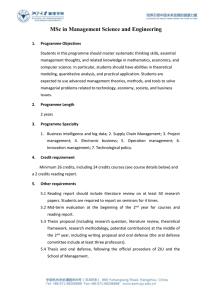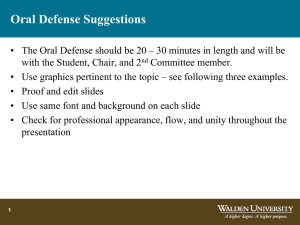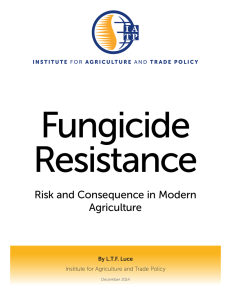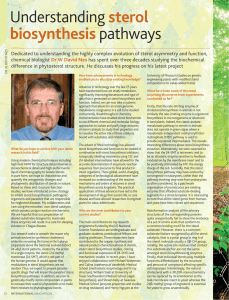Powdery mildew management for melons: Fungicide mode of action Melon powdery mildew
advertisement
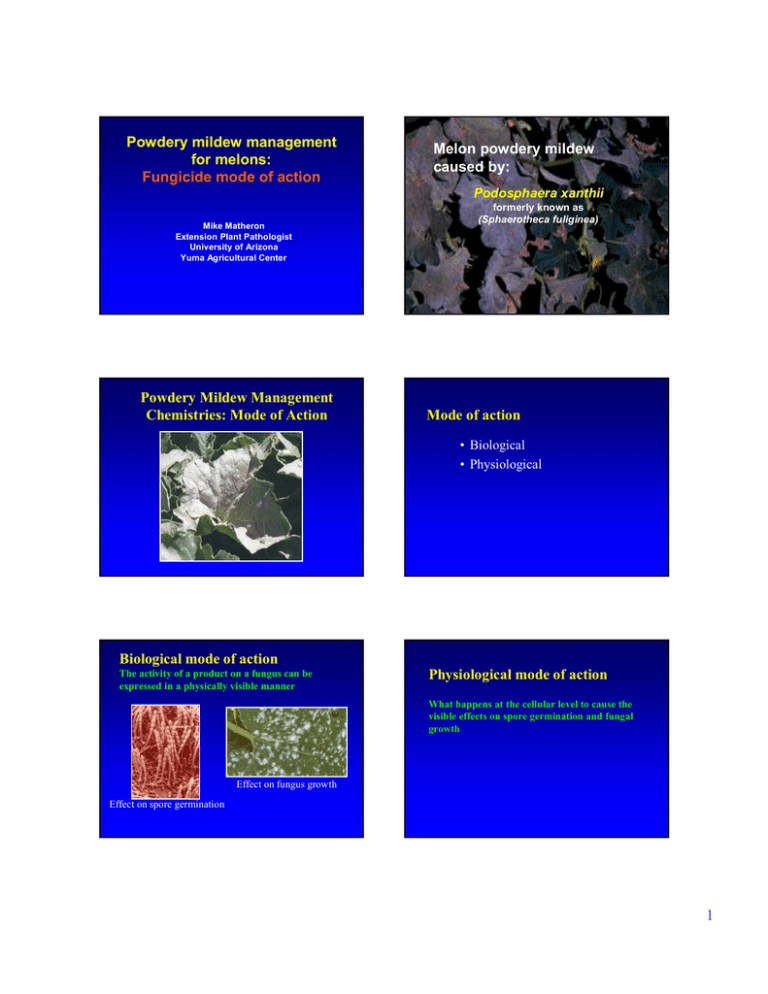
Powdery mildew management for melons: Fungicide mode of action Melon powdery mildew caused by: Podosphaera xanthii Mike Matheron Extension Plant Pathologist University of Arizona Yuma Agricultural Center Powdery Mildew Management Chemistries: Mode of Action formerly known as (Sphaerotheca fuliginea) Mode of action • Biological • Physiological Biological mode of action The activity of a product on a fungus can be expressed in a physically visible manner Physiological mode of action What happens at the cellular level to cause the visible effects on spore germination and fungal growth Effect on fungus growth Effect on spore germination 1 Physiological mode of action A typical plant cell and components Thin-section transmission electron microscope view What happens at the cellular level to cause the visible effects on spore germination and fungal growth Awareness of the physiological mode of action is important for resistance management and preservation of fungicide effectiveness From: Biochemistry & Molecular Biology of Plants Diagrammatic compared to thin-section view of a plant cell Fungicide groups, based on mode of action, as created by the Fungicide Resistance Action Committee • • • • • • • • • • • Multi-site contact activity Nucleic acids synthesis Mitosis and cell division Respiration Amino acids and protein synthesis Signal transduction Lipids and membrane synthesis Sterol biosynthesis in membranes Glucan and cell wall synthesis Melanin synthesis in cell wall Host plant defense induction The physiological mode of action • Fungicides are metabolic pathway inhibitors • Fungicides can be placed in groups with respect to their general mode of action – This has been done by the Fungicide Resistance Action Committee (FRAC) Fungicide groups containing products active against powdery mildew on melons • • • • • • Multi-site contact activity Mitosis and cell division Respiration Signal transduction Sterol biosynthesis in membranes Host plant defense induction 2 Multi-site contact activity Multi-site contact activity • Chemical group: Inorganics Sulfur: – Disrupts electron transport along the cytochromes Resistance risk: Low Multi-site contact activity • Chemical group: Chloronitriles Chlorothalonil (Bravo) – Inactivate amino acids, proteins and enzymes by combining with amino and thiol groups • Chemical group: Inorganics Potassium bicarbonate (Armicarb, Kaligreen) – Kills pathogen and spores by a combination of osmotic pressure, pH and specific carbonate and bicarbonate ion effects Resistance risk: Low Multi-site contact activity Neem seed oil (Trilogy) – Prevents spore germination and kills mycelium on leaf surface Resistance risk: Low Resistance risk: Low Inhibition of mitosis and cell division • Group name: MBC (Methyl benzimidazole carbamates) • Thiophanate-methyl (Topsin) – Inhibit DNA synthesis (nuclear division) – β-tubulin assembly in mitosis Inhibition of respiration (in mitochondria) • Group name: Carboxamides Boscalid (Endura) – Complex II: inhibits succinate dehydrogenase Resistance risk: Medium Resistance risk: High 3 Inhibition of respiration (in mitochondria) • Group name: Qol-fungicides - Quinone outside inhibitors Strobilurins: Azoxystrobin (Quadris); Pyraclostrobin (Cabrio); Trifloxystrobin (Flint) Inhibition of respiration (in mitochondria) • Group name: Qol-fungicides - Quinone outside inhibitors Strobilurins: Azoxystrobin (Quadris) Pyraclostrobin (Cabrio) Trifloxystrobin (Flint) – Complex III: blocks the cytochrome bc1 at the Qo site Resistance risk: High Structural organization of a mitochondrian Electron transfer chain in the inner membrane of mitochondria From: Biochemistry & Molecular Biology of Plants From: Biochemistry & Molecular Biology of Plants Electron transfer chain in the inner membrane of mitochondria X X Endura From: Biochemistry & Molecular Biology of Plants Signal transduction disruption • Group name: Quinolines Quinoxyfen (Quintec) – G-proteins in early cell signalling (proposed) Resistance risk: Medium Cabrio Flint Quadris 4 Inhibition of sterol biosynthesis in membranes • Ergosterol is the major sterol in most fungi • It is essential for membrane structure and function Inhibition of sterol biosynthesis in membranes • Group name: DMI (Demethylation inhibitors) • Myclobutanil (Rally) • Triflumazole (Procure) – Inhibits C14-demethylase in sterol biosynthesis Resistance risk: Medium Host plant defense induction (Plant activators) Plant activators • Acibenzolar-S-methyl (Actigard) • In contrast to conventional fungicides, plant activators have no direct effect on pathogens • Plant activators induce plants to produce natural disease-fighting compounds Plant activators stimulate natural plant defense mechanisms • Salicylic acid pathway – Induces SAR (systemic acquired resistance), a natural biological defense response to pathogen attack • Jasmonic Acid Pathway - Induces the production of disease and insect defense compounds • Harpin (Messenger) • Some biological control organisms (Serenade) • Also may control plant diseases by production of compounds directly toxic to the pathogen Salicylic Acid Pathway • Production of active oxygen (hydrogen peroxide, peroxidase) • Peroxidases have been associated with fungal cell wall degradation and pathogen defense signaling • Thickening plant cell wall • Increasing lignification • Production of phenolic esters that strengthen cross linking 5 Salicylic Acid Pathway • Systemic and local accumulation of Pathogenesis Related Proteins (PR-Proteins) • chitinases • ß-1,3 Glucanase • Systemic accumulation of anti-microbial compounds called phytoalexins Chitinases • Chitin is the major component of all fungal cell walls except for the Oomycetes • Chitinases break down fungal cell walls • Chitinases can break down insect exo-skeletons • Activity is greatly enhanced by Glucanase ß-1,3 Glucanases • Glucans and cellulose are the major components of Oomycete cell walls • Antifungal activity is most often in combination with Chitinase Jasmonic Acid Pathway Jasmonic acid induces the production of disease and insect defense compounds – Defense Proteins – Phytochemicals • Direct defense: Degrade fungal cell walls • Indirect defense: Promoting the release of oligosaccharides that act as elicitors of defense reactions Phytochemicals • Different from phytoalexins in that phytochemicals are induced by wounding • Phenolics – Furanocoumarins, Coumarins, Tannins, Lignin, other phenolics • Terpenoids • Alkaloids Examples of plant activators •Acibenzolar-S-methyl (Actigard) •Harpin (Messenger) •Some biological control organisms (Serenade) •Also may control plant diseases by production of compounds directly toxic to the pathogen 6 Mode of action - Messenger Mode of action - Actigard Salicylic Acid Pathway Classical SAR SAR gene expression harpin Jasmonic Acid Pathway Pest resistance Ion-exchange receptor Signal amplification PDF1.2 and other gene expression Increased nutrient uptake Gene expression involved in plant growth Increased photosynthesis Induction of Systemic Acquired Resistance Slide courtesy of Syngenta Slide courtesy of Eden Bioscience Concluding thought: Why is it important to know the physiological mode of action of fungicides? • For resistance management and preservation of fungicide effectiveness • Incorporate fungicides with different modes of action into a disease management program – In alternation or as a mixture This presentation will be available online at the Arizona Crop Information Site (ACIS) http://ag.arizona.edu/crops 7



